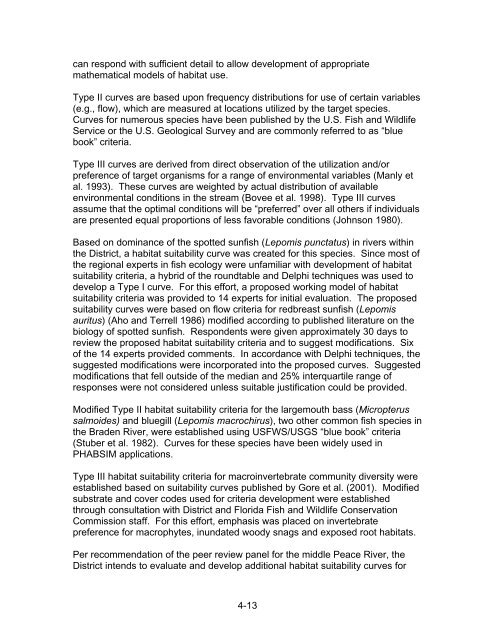Chapter 1 Minimum Flows and Levels - Southwest Florida Water ...
Chapter 1 Minimum Flows and Levels - Southwest Florida Water ...
Chapter 1 Minimum Flows and Levels - Southwest Florida Water ...
Create successful ePaper yourself
Turn your PDF publications into a flip-book with our unique Google optimized e-Paper software.
can respond with sufficient detail to allow development of appropriate<br />
mathematical models of habitat use.<br />
Type II curves are based upon frequency distributions for use of certain variables<br />
(e.g., flow), which are measured at locations utilized by the target species.<br />
Curves for numerous species have been published by the U.S. Fish <strong>and</strong> Wildlife<br />
Service or the U.S. Geological Survey <strong>and</strong> are commonly referred to as “blue<br />
book” criteria.<br />
Type III curves are derived from direct observation of the utilization <strong>and</strong>/or<br />
preference of target organisms for a range of environmental variables (Manly et<br />
al. 1993). These curves are weighted by actual distribution of available<br />
environmental conditions in the stream (Bovee et al. 1998). Type III curves<br />
assume that the optimal conditions will be “preferred” over all others if individuals<br />
are presented equal proportions of less favorable conditions (Johnson 1980).<br />
Based on dominance of the spotted sunfish (Lepomis punctatus) in rivers within<br />
the District, a habitat suitability curve was created for this species. Since most of<br />
the regional experts in fish ecology were unfamiliar with development of habitat<br />
suitability criteria, a hybrid of the roundtable <strong>and</strong> Delphi techniques was used to<br />
develop a Type I curve. For this effort, a proposed working model of habitat<br />
suitability criteria was provided to 14 experts for initial evaluation. The proposed<br />
suitability curves were based on flow criteria for redbreast sunfish (Lepomis<br />
auritus) (Aho <strong>and</strong> Terrell 1986) modified according to published literature on the<br />
biology of spotted sunfish. Respondents were given approximately 30 days to<br />
review the proposed habitat suitability criteria <strong>and</strong> to suggest modifications. Six<br />
of the 14 experts provided comments. In accordance with Delphi techniques, the<br />
suggested modifications were incorporated into the proposed curves. Suggested<br />
modifications that fell outside of the median <strong>and</strong> 25% interquartile range of<br />
responses were not considered unless suitable justification could be provided.<br />
Modified Type II habitat suitability criteria for the largemouth bass (Micropterus<br />
salmoides) <strong>and</strong> bluegill (Lepomis macrochirus), two other common fish species in<br />
the Braden River, were established using USFWS/USGS “blue book” criteria<br />
(Stuber et al. 1982). Curves for these species have been widely used in<br />
PHABSIM applications.<br />
Type III habitat suitability criteria for macroinvertebrate community diversity were<br />
established based on suitability curves published by Gore et al. (2001). Modified<br />
substrate <strong>and</strong> cover codes used for criteria development were established<br />
through consultation with District <strong>and</strong> <strong>Florida</strong> Fish <strong>and</strong> Wildlife Conservation<br />
Commission staff. For this effort, emphasis was placed on invertebrate<br />
preference for macrophytes, inundated woody snags <strong>and</strong> exposed root habitats.<br />
Per recommendation of the peer review panel for the middle Peace River, the<br />
District intends to evaluate <strong>and</strong> develop additional habitat suitability curves for<br />
4-13
















